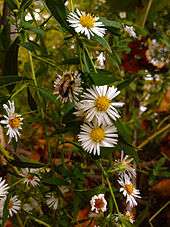Symphyotrichum lanceolatum
| Symphyotrichum lanceolatum | |
|---|---|
| | |
| Scientific classification | |
| Kingdom: | Plantae |
| (unranked): | Angiosperms |
| (unranked): | Eudicots |
| (unranked): | Asterids |
| Order: | Asterales |
| Family: | Asteraceae |
| Subfamily: | Asteroideae |
| Tribe: | Astereae |
| Genus: | Symphyotrichum |
| Species: | S. lanceolatum |
| Binomial name | |
| Symphyotrichum lanceolatum (Willd.) G.L.Nesom | |
| Synonyms | |
|
Aster lanceolatus | |
Symphyotrichum lanceolatum (syn. Aster lanceolatus) is a species of flowering plant in the aster family, Asteraceae. It is native to Canada and the United States. Common names include panicled aster, tall white aster,[1] eastern line aster, lance-leaf aster, narrow-leaf Michaelmas daisy, and white-panicle aster.[2]
Description
This perennial herb has a thick, erect stem that often grows 1.5 meters tall or more, sometimes approaching 2 meters. It has a stout rhizome and can spread to form a colony. The leaf blades have winged petioles and may sheath the stem at the bases. The largest, near the base of the plant, are up to about 15 centimeters long. Those higher on the stem are smaller. The lower leaves may have toothed edges. The inflorescence is usually a large, branching array of many flower heads of varying size. There are 16 to 50 ray florets per head, each measuring 3 to 14 millimeters long, in shades of blue, pink, or white. The disc florets bloom yellow and turn purple.[3]
This species is currently divided into five varieties or two subspecies, depending on the authority.[3]
Uses
The Zuni people used this plant for wounds and nosebleed. The Iroquois used it to treat fever.[4]
References
| Wikimedia Commons has media related to Symphyotrichum lanceolatum. |
- ↑ Dickinson, T., et al. (2004) The ROM Field Guide to Wildflowers of Ontario. Toronto: Royal Ontario Museum. p. 190.
- ↑ Symphyotrichum lanceolatum. Germplasm Resources Information Network (GRIN).
- 1 2 Symphyotrichum lanceolatum. Flora of North America.
- ↑ Symphyotrichum lanceolatum. Native American Ethnobotany. University of Michigan, Dearborn.
External links
- Symphyotrichum lanceolatum. USDA PLANTS
- Panicled Aster. WIKIMEDIA COMMONS

